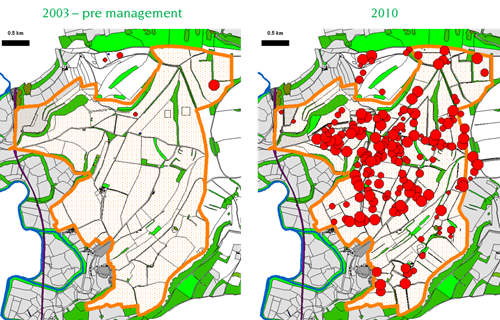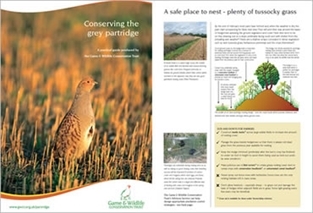Key findings
- One farm on the Sussex Study area has reinstated a sustainable wild grey partridge shoot by improving habitat provision and instigating predator control.
- Grey partridge breeding density increased from 0.3 pairs per 100ha in 2003 to nearly 20 pairs per 100ha in 2010.
- Sustainable shooting was possible in 2009 and 2010, with the funds generated helping to offset the costs of management.
 The GWCT has carried out extensive research into both the causes of grey partridge declines and the methods that employed to reverse these declines. One of the landowners on the area covered by our long-running Sussex study has put in place the necessary habitat and management improvements, resulting in grey partridge densities of nearly 20 pairs per 100ha, enough to support a sustainable wild grey partridge shoot.
The GWCT has carried out extensive research into both the causes of grey partridge declines and the methods that employed to reverse these declines. One of the landowners on the area covered by our long-running Sussex study has put in place the necessary habitat and management improvements, resulting in grey partridge densities of nearly 20 pairs per 100ha, enough to support a sustainable wild grey partridge shoot.
Work on restoring grey partridge numbers began in 2003/04, with the creation of conservation headlands and beetle banks for brood rearing and nesting cover, as well as the establishment of game covers to provide both winter food and escape cover. Beetle banks not only reduced the average field size from 21ha to 9ha but also allowed the crop rotation to be tweaked to ensure different crops on either side of a beetle bank. This was to guarantee that birds had cover and food available throughout the year. Game feeders provided each partridge pair with additional food (wheat) from October through to July. In order to provide winter food and escape cover, the farming team planted wild bird cover strips, containing kale and chicory. The cost of this habitat improvement was partially offset by using environmental stewardship options available through the Higher Level Scheme.
In addition to the habitat management described above, the landowner put in place legal predator control (carried out by a team of three gamekeepers) targeted at controlling predation of sitting hens, nests and young chicks. Numbers of both corvids and foxes are controlled, with particular attention paid to this aspect of management during the nesting season.
The results of all this efforts are plain to see when comparing autumn grey partridge counts from the area in 2003 to those in 2010 (Figure 1). The number of spring pairs across the managed area has increased from three in 2003 to 202 in 2010. Two demographic parameters are responsible for this improvement, increased brood production rate (due to improved nesting cover and predator control during nesting) and increased chick survival (due to improved brood-rearing cover).
Figure 1: Grey partridge autumn counts from 2003 (the year before the management started) and in 2010 (when both gamekeepering and habitat management were fully implemented). The red dots are individual grey partridge coveys, with the size of the dot relative to the number of young in each covey

The improvement in grey partridge numbers have meant that the landowner was able to have two days of shooting in 2009 and 2010, the proceeds of which helped to defray the costs of both habitat management and predator control. The farm has won the prestigious Purdey Award in 2010 and serves as a shining example of what can be achieved with commitment and perseverance.
Further reading
- Ewald, J.A., Potts, G.R., & Aebischer, N.J. (2012). Restoration of a wild grey partridge shoot: a major development in the Sussex study, UK. Animal Biodiversity and Conservation, 35: 363-369.
- Potts, G.R., Corbet, S.A., West, R., Streeter, D., Flegg, J. & Silvertown, J. (eds) (2012). Partridges. Countryside Barometer. New Naturalist Library Book 121. Collins, London.
- Potts, G.R. (2009). Restoring a grey partridge (Perdix perdix) population and the future of predation control. In: Cederbaum, S.B., Faircloth, B.C., Terhune, T.M., Thompson, J.J. & Carroll, J.P. (eds) Gamebird 2006: Quail VI and Perdix XII: 24-25. Warnell School of Forestry and Natural Resources, Athens, USA.
Get your FREE Grey Partridge Conservation Guide
An essential guide to conserving the grey partridge produced by the Game & Wildlife Conservation Trust.
What's inside your FREE guide
✓ The decline of a common farmland bird
✓ A safe place to nest - plenty of tussocky grass
✓ Chick survival - insect food is crucial
✓ Surviving winter and spring - food and cover
✓ Conservation targets - Partridge Count Scheme
✓ Grey partridges and shooting
✓ Common questions
Download guide now >